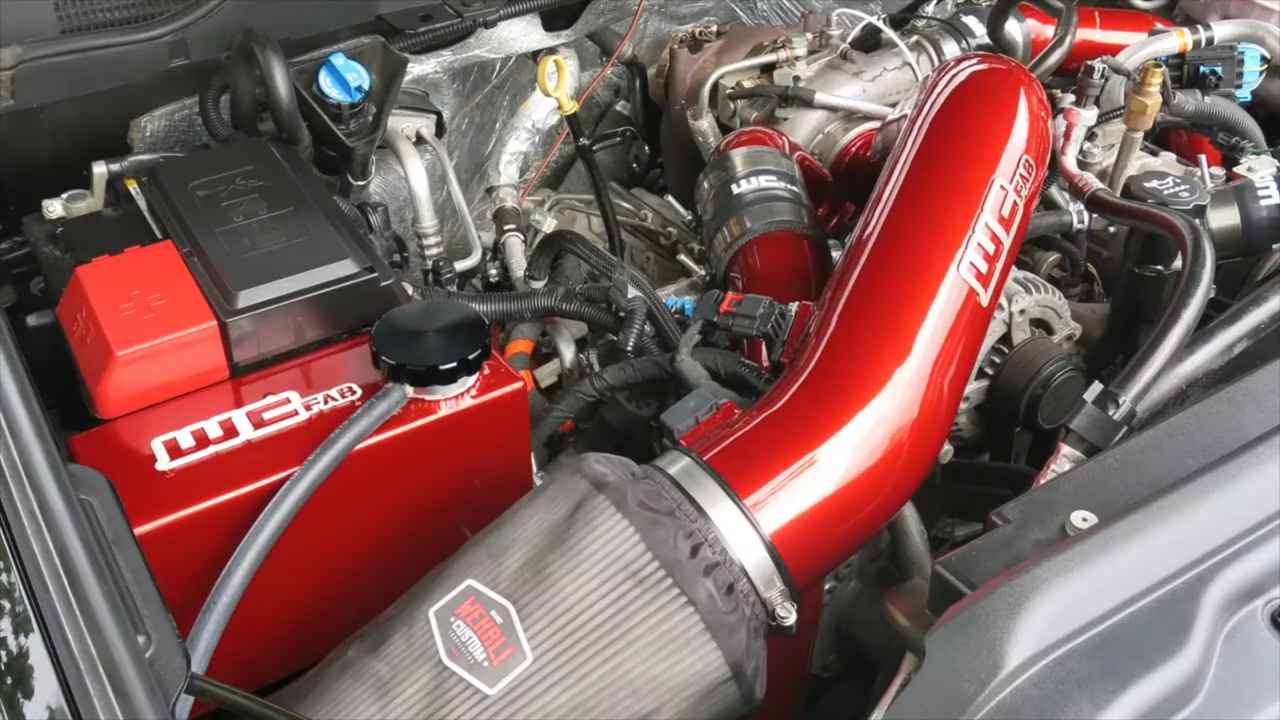 Hey guys, Jake from 8020 Media here. Today, we’re going to be doing a video on GM’s 6.6-liter Duramax L5P. The L5P was released in 2017 following the LML. The LML had a number of problems with it which were addressed in the L5P, and so the L5P received a number of important or noteworthy updates.
Hey guys, Jake from 8020 Media here. Today, we’re going to be doing a video on GM’s 6.6-liter Duramax L5P. The L5P was released in 2017 following the LML. The LML had a number of problems with it which were addressed in the L5P, and so the L5P received a number of important or noteworthy updates.
 The first one is, they switched from a variable vein turbo to a variable geometry turbo. They also switched from Garrett to BorgWarner as the supplier there. They got rid of the Bosch CP4.2 injection pump since those things were known to grenade and take out essentially the whole fueling system. They switched over to the DENSO HP4 injection pump and, alongside that, they switched from Bosch injectors to DENSO injectors.
The first one is, they switched from a variable vein turbo to a variable geometry turbo. They also switched from Garrett to BorgWarner as the supplier there. They got rid of the Bosch CP4.2 injection pump since those things were known to grenade and take out essentially the whole fueling system. They switched over to the DENSO HP4 injection pump and, alongside that, they switched from Bosch injectors to DENSO injectors. These DENSO injectors have a 20% increase in flow. Additionally, they added a cool hood scoop to the hood of the trucks to help provide additional intake airflow.So moving on to common problems,
These DENSO injectors have a 20% increase in flow. Additionally, they added a cool hood scoop to the hood of the trucks to help provide additional intake airflow.So moving on to common problems, So far the L5P has been extremely reliable, and so there really aren’t that many common problems with it. However, there are a few things that are noteworthy to mention, but none of them are really that material or that big of a problem in terms of longevity and reliability. But jumping into the issues anyways.
So far the L5P has been extremely reliable, and so there really aren’t that many common problems with it. However, there are a few things that are noteworthy to mention, but none of them are really that material or that big of a problem in terms of longevity and reliability. But jumping into the issues anyways. The first one’s with the MAP sensor. Because of exhaust gas recirculation and the location of the MAP sensor, the MAP sensor gets clogged up from diesel soot pretty frequently. This issue can be solved by pulling out the MAP sensor and cleaning it with a sensor cleaning solution. S&B filters also came out with a sensor spacer that just adds a little bit of additional space for the sensor and helps protect it from building up so much soot. It doesn’t necessarily fix the issue with the sensor, but it does reduce how frequently you have to clean the sensor. So, overall, not a huge issue, but the MAP sensor can fail and does build up with soot frequently, which will cause it to throw a number of performance-related issues like misfires, rough idling, sluggish acceleration, and things like that.
The first one’s with the MAP sensor. Because of exhaust gas recirculation and the location of the MAP sensor, the MAP sensor gets clogged up from diesel soot pretty frequently. This issue can be solved by pulling out the MAP sensor and cleaning it with a sensor cleaning solution. S&B filters also came out with a sensor spacer that just adds a little bit of additional space for the sensor and helps protect it from building up so much soot. It doesn’t necessarily fix the issue with the sensor, but it does reduce how frequently you have to clean the sensor. So, overall, not a huge issue, but the MAP sensor can fail and does build up with soot frequently, which will cause it to throw a number of performance-related issues like misfires, rough idling, sluggish acceleration, and things like that. But ultimately, relatively minor problem. The second one is the number four fuel injector. So, for whatever reason, the cylinder four fuel injector connector has seemed to have some problems and it goes bad. And what this does is it sends the engine into limp mode, and it also throws a P0204 engine code. The injector itself has failed.
But ultimately, relatively minor problem. The second one is the number four fuel injector. So, for whatever reason, the cylinder four fuel injector connector has seemed to have some problems and it goes bad. And what this does is it sends the engine into limp mode, and it also throws a P0204 engine code. The injector itself has failed. However, whenever we see this issue, it mostly tends to be with the connector and not with the injector itself. Two ways to fix this are either using an LBZ connector or using a gold-plated connector. Additionally, there was a fuel injector recalibration recall in February of 2019. That recall is not known to fix this issue. However, if you haven’t had that recall done it’s worthwhile to get it taken care of. However, this really isn’t that common of a problem, but it has been brought up and mentioned a number of times on forums and online. Just since it is very specific to the number four cylinder.
However, whenever we see this issue, it mostly tends to be with the connector and not with the injector itself. Two ways to fix this are either using an LBZ connector or using a gold-plated connector. Additionally, there was a fuel injector recalibration recall in February of 2019. That recall is not known to fix this issue. However, if you haven’t had that recall done it’s worthwhile to get it taken care of. However, this really isn’t that common of a problem, but it has been brought up and mentioned a number of times on forums and online. Just since it is very specific to the number four cylinder. The third most common problem is with the DEF heater system. DEF fluid freezes at 12 degrees, and so the DEF tank has a built-in heater to help heat up the DEF fluid so that it doesn’t freeze. Since frozen fluid can’t be injected into the SER system, the heater is known to fail. Ultimately not very common. However, we have seen a few instances of this happening. This happens more so in extremely cold climates, where the DEF frequently does get below 12 degrees and freeze. But like I mentioned, not that material or that common of a problem.
The third most common problem is with the DEF heater system. DEF fluid freezes at 12 degrees, and so the DEF tank has a built-in heater to help heat up the DEF fluid so that it doesn’t freeze. Since frozen fluid can’t be injected into the SER system, the heater is known to fail. Ultimately not very common. However, we have seen a few instances of this happening. This happens more so in extremely cold climates, where the DEF frequently does get below 12 degrees and freeze. But like I mentioned, not that material or that common of a problem. And then the last thing really isn’t as much of a problem, but more so a limitation. And that’s the Allison 1000 transmission. And this is the case on pretty much any Duramax diesel.
And then the last thing really isn’t as much of a problem, but more so a limitation. And that’s the Allison 1000 transmission. And this is the case on pretty much any Duramax diesel.The Allison 1000, while a great transmission, is not very capable from a power perspective. And so the Allison 1000 10-speed that’s included on these trucks can only handle about 500 wheel horsepower. Considering the L5P produces 445 crank horsepower, you can get pretty easily to 500 wheel horsepower with a simple tune and some bolt-on modifications. And so it’s not very difficult to get the transmission to its limit or push the transmission past its limit. One thing that can help with this is transmission tuning.
 If you get EFILive and put a transmission tune on it, the transmission can hold pretty reliably at 500 rear-wheel horsepower and can handle up to about 550. However, if you want to go beyond that, you’re going to need a built transmission, which is going to run you somewhere near five grand.
If you get EFILive and put a transmission tune on it, the transmission can hold pretty reliably at 500 rear-wheel horsepower and can handle up to about 550. However, if you want to go beyond that, you’re going to need a built transmission, which is going to run you somewhere near five grand.And so that’s just a limit from a performance modification standpoint in case you’re looking at modding your L5P. There have been a couple other small things normal with any diesel engine like issues with regen cycles. There have been some small coolant system issues, but overall there really aren’t any issues with this truck that are catastrophic or serious in nature that give us any concerns to the long-term longevity and reliability of this engine.
The MAP sensor failure is not a huge issue so long as you clean it frequently. You might have to replace it, but it’s not very expensive. Fuel injector connector issues are not common and also not that difficult to replace. If you do have an issue with the connector, the DEF heater doesn’t fail that frequently either. And if it does, it’s not the most difficult or the worst repair.
And then the Allison transmission isn’t an issue at all. It’s only an issue if you want to modify it and put out more than 500 wheel horsepower. So ultimately, there just really aren’t that many issues with this engine, and certainly not any that give us reliability concerns by any means. And so this is by far the best diesel engine that GM has produced. Probably since the LBZ and some of the other kind of pre-emissions diesel engines. The emission systems on the L5P have seemed to hold up pretty well so far and those tend to be common failure points on most diesel engines.
And so overall, we have high hopes for the L5P. Extremely reliable, certainly offers some of the best reliability on the diesel market right now. That covers it for our video on common problems with the Duramax L5P. If you appreciated this video, we would love it if you subscribed, gave this video a like, and tuned in to our future content.
As always, if you’re looking for additional information, we have a blog post written on this topic, which you can find in the description.